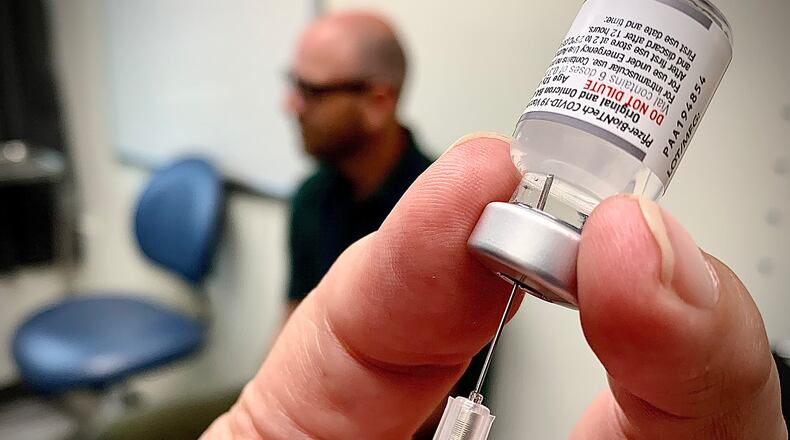The number of COVID-19 cases and hospitalizations fluctuated up and down throughout 2023. The state was coming down from a spike in early January 2023 with approximately 2,428 cases recorded on Jan. 3, 2023, according to data from the Ohio Department of Health COVID-19 dashboard. Increases were seen in early September, going down until late October, when there a gradual increase began to the end of the year.
Even with ups and downs, Ohio’s 2023 COVID numbers are dramatically down from 2022′s highest levels — 32,715 cases on Jan. 3, 2022; 366 hospitalizations on Jan. 7; and 192 deaths on Jan. 13, according to ODH data.
Cases of COVID-19 continue to be reportable in Ohio, but cases are under-reported due to the availability of at-home testing. Many who do test positive just stay home and self-treat, with no notification. ODH considers hospitalizations to be a better indicator of COVID’s impact, and current hospitalization numbers remain lower than at the same time in each of the past two years.
ODH officially recorded 12,453 COVID hospitalizations in 2023 — roughly equivalent to the entire population of West Carrollton, Urbana or Franklin. That number is down 62% from Ohio’s 33,380 COVID hospitalizations in 2022, but there’s some uncertainty to the data.
The state cautions that hospitalizations are under-reported on ODH’s date-specific dashboard, as 15,201 hospitalizations have been excluded due to the admission date for those hospitalizations being unknown. Combining the two hospitalization numbers could put the 2023 number at 27,654.
The state has had 147,202 COVID hospitalizations since the pandemic began, the majority of them in 2020 and 2021.
| County | 2022 cases | 2022 hospitalizations | 2022 deaths | 2023 cases | 2023 hospitalizations | 2023 deaths | Hospitalizations excluded where the admission date is unknown and could have happened at any point in the pandemic |
|---|---|---|---|---|---|---|---|
| Butler | 47,390 | 1,099 | 277 | 11,515 | 405 | 57 | 872 |
| Champaign | 3,855 | 75 | 47 | 939 | 2 | 8 | 57 |
| Clark | 16,774 | 155 | 172 | 3,564 | 4 | 36 | 413 |
| Darke | 5,349 | 118 | 49 | 1,272 | 60 | 5 | 69 |
| Greene | 19,408 | 705 | 122 | 4,999 | 297 | 22 | 444 |
| Miami | 11,397 | 420 | 123 | 2,811 | 143 | 22 | 121 |
| Montgomery | 65,335 | 3,542 | 583 | 16,831 | 1,677 | 115 | 529 |
| Preble | 4,141 | 200 | 41 | 1,139 | 73 | 7 | 69 |
| Shelby | 4,763 | 86 | 41 | 689 | 29 | 19 | 65 |
| Warren | 29,207 | 341 | 159 | 6,631 | 120 | 20 | 178 |
| All of Ohio | 1,224,420 | 33,380 | 9,329 | 323,473 | 12,453 | 1,925 | 15,201 |
Credit: JIM NOELKER
Credit: JIM NOELKER
According to ODH, COVID was responsible for 1,925 Ohioans’ deaths in 2023.
The availability of COVID-19 vaccines, along with updated versions of the vaccine, are credited for part of the decrease in cases, hospitalizations, and deaths, experts say, though fewer than 10% of Ohioans have received the updated vaccine.
People who are more at risk of complications, such as people who are older, are more likely to stay up to date on COVID vaccinations.
“The vaccine continues to be developed, and there’s new versions of the vaccine available to keep up with the emerging strains as best possible, so we have seen an overall lessening in the effect of COVID, generally speaking, across the population,” Suffoletto said. “There still are instances where people are getting sick and going to the hospital, but that has lessened to a greater degree.”
New variants continue to emerge, but vaccines still reduce the risk of hospitalizations, severe illness, and death due to COVID, public health officials say.
“As of the week ending Dec. 2, the Omicron variant JN.1 had accounted for 4.59% of Ohio cases that have been genomically sequenced,” ODH said. ODH’s COVID-19 variant dashboard can be found in the state’s datasets at data.ohio.gov.
The World Health Organization considers JN.1 to be a low public health risk and vaccines that are currently available should provide protection against this variant, the organization said.
“ODH of course continues to encourage Ohioans to receive the latest COVID-19 vaccine as their best defense against severe illness,” the department said.
The wide availability of at-home COVID tests help people know when they have the virus, so they know to stay home to prevent spreading it.
People have developed their own strategies at dealing with COVID, making sure to take cold-like symptoms more seriously.
“They’re not just ignoring symptoms when they come up,” Suffoletto said. “In the past, people may have had congestion or cold-like symptoms and just ignored that or wrote it off as the cold. Now I think many more people are considering COVID and taking the test and taking precautions.”
Even though hospitalizations and deaths due to COVID decreased in 2023 over 2022, public health officials encourage people to stay proactive with vaccinations.
“We don’t want to lose sight of the fact that even though compared to years past, there’s a lower number of cases, it’s still very important for people to get vaccinated to help keep those cases down, to help keep people out of the hospital, to help keep people from being sick,” Suffoletto said.
About the Author


